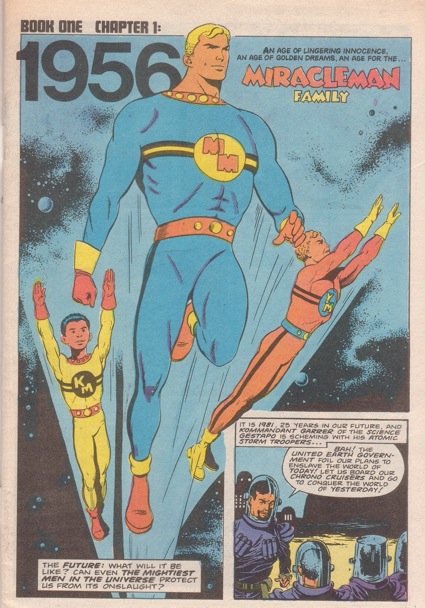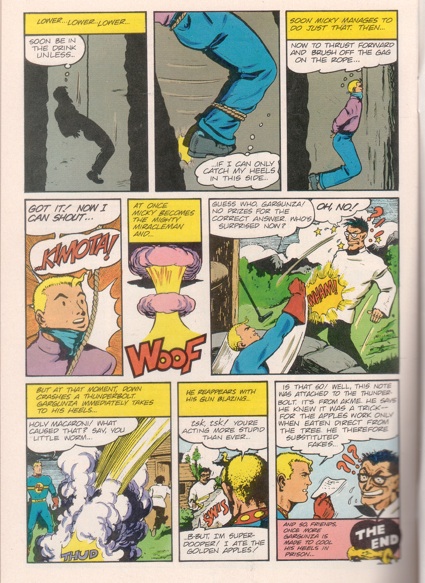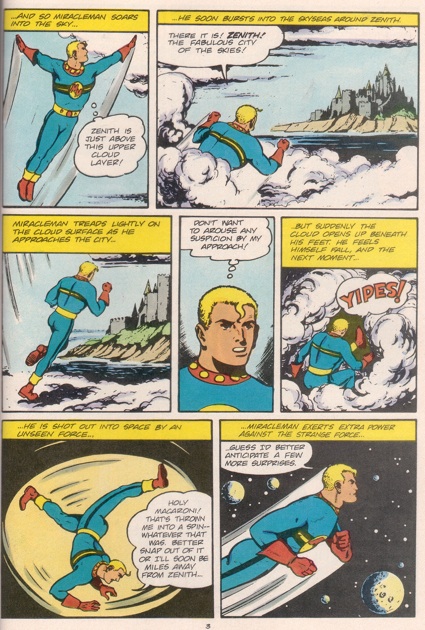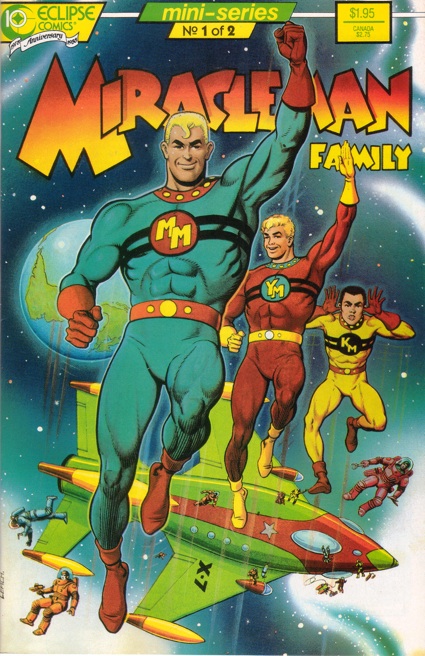Before the comic book world had The Dark Knight and Watchmen, 1982 gave us a revolutionary, revamped Marvelman in the pages of Warrior #1—a character that a few years later achieved more fame and acclaim under his new name of Miracleman, courtesy of American publisher Eclipse Comics.
Before the rage of ultra-realism, sex, violence and rock ’n’ roll were in all mainstream superhero storytelling, writer Alan Moore and a group of committed artists did it first and better with Miracleman, a forerunner to the dramatic possibilities that an entire industry would attempt to force onto all their heroes. This uprising was the first time that an established superhero character was pushed to its fullest dramatic possibilities, and then some. Here was a costumed heroic comic character ready to give the entire world peace, a true utopia unlike any ever seen in the art form. Subsequently, a young Neil Gaiman and Mark Buckingham would pick up the torch and continue to beautifully explore the ramifications of said bliss.
Now that it appears Marvel Comics has settled the copyright nightmare that have kept these stories out-of-print for over a decade, a new generation is ready to discover perhaps the greatest superhero novella ever told.
The original Marvelman was a character invented not by divine inspiration, but by practical necessity. Back in the early 1950s, Len Miller and Son (an independent British publishing outfit in the ’50s and ’60s) produced all sorts of comics in a variety of genres, many of which were American reprints with some new filler content. The most popular of all Miller’s titles were the ones featuring the adventures of Captain Marvel, Captain Marvel Jr., Mary Marvel and The Marvel Family. All of this content and the characters therein were licensed from Fawcett Publications, U.S.A. But trouble was brewing back in the States; Fawcett was locked in a court battle with National Publications/ DC Comics, when the latter claimed copyright infringement in that Captain Marvel was too similar to their Superman property. By 1953, Fawcett agreed to terms retiring the entire Captain Marvel family, settling with DC Comics for $400,000.

Across the pond, Len Miller was perplexed with the scenario that the days of his most lucrative titles were seemingly coming to an end. In desperation, he made a phone call to Mick Anglo (an editorial packager of content for comics and magazines) for an answer to his dilemma.
All throughout the ’50s, Mick Anglo (born Michael Anglowitz) ran a small studio that gave employment to many hungry and lowly paid writers and artists (mostly ex-servicemen) in modest Gower Street, London. He was an independent operator who had provided cover art and content for Len Miller’s company, amongst other clients. Anglo’s solution to Miller’s problem was simply to not reinvent the wheel, but give the readers what they wanted under a different guise. As Anglo told me in 2001, “Yes, it was my creation except everything is based on somebody else: a bit of this and a bit of that. With Superman, he’s always wearing this fancy cloak with a big ‘S’ on his chest, very intricate really. I thought that was too hard to emulate, so I tried to create something that was easy to draw and easy to market. I did away with the cloak so that I didn’t have to draw the cloak, which was awkward to draw, and played with a gravity belt, and they could do anything without all these little gimmicks.”
Without missing a beat (or a week), effective January 31st, 1954, the final British issues of Captain Marvel and Captain Marvel Jr., respectively, featured an editor’s letter announcing the retirement of the former heroes and the imminent arrival of the brand new Marvelman (a.k.a Mickey Moran) and Young Marvelman (a.k.a. Dicky Dauntless), in the very next issue—members of the Captain Marvel fan clubs were automatically rolled over to the brand new Marvelman fan clubs.

Let’s face it: Marvelman wasn’t at all unlike his predecessor. He was a young newsboy who could transform into an adult-sized superhero with a magic word; he was just as powerful as Captain Marvel; he basically had all his traits; he even had a new diminutive evil thorn named Gargunza, who could have easily been Dr. Sivana’s lost brother. Any differences were purely superficial. Unlike the darker features of Captains Marvel and Marvel Jr., the doppelganger and his junior counterpart were blond and blue-eyed. And instead of a Mary Marvel clone, a child hero named Kid Marvelman (a.k.a. Johnny Bates) was later introduced in the pages of Marvelman #102. Despite these minor changes, young British readers were apparently naïve enough to embrace the new characters, because Marvelman and his related titles would remain a constant for nine years!
The original Marvelman comics were produced hastily in a studio environment; the only goal was to get the books done rapidly and move on to the next paying assignment—most artists were paid only one pound for a full page of art. A lot of times the story, art and lettering suffered from the hectic time-crunch; many of the early Marvelman stories are fairly straightforward, derivative and workman-like in substance. The very best of the vintage Marvelman stories had a nice, whimsical feel that invited children to devour them; many of the finest tales were illustrated by an up-and-coming Don Lawrence (of Trigan Empire fame). With the rare exception of a few specials, these weekly British comics were black-and-white publications on very shabby paper that kids could buy for mere pennies, because essentially this work was strictly child’s fare material that never pretended to be high art or anything else.

What made Marvelman a remarkable phenomenon was the fact that he was England’s first truly successful superhero. Unlike us Americans (yesterday or today), post-World War II British comics readers have always enjoyed a bit more variety in their funny books. Basically, the superhero genre was left to America.
By 1960, Mick Anglo departed the title, the book’s sales were in a downfall, and there was no influx of new stories. Ultimately, Marvelman and Young Marvelman would uneventfully cease publication in 1963. It appeared that the characters would simply fade into obscurity… Then came the ’80s.
Next Time: Alan Moore’s Miraculous Revival of Marvelman.
George Khoury is the author of the upcoming brand-new edition of Kimota! The Miracleman Companion, The Extraordinary Works of Alan Moore and more.










